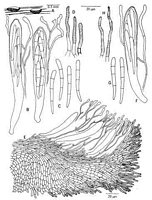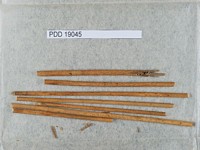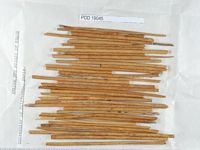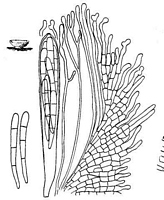|
 Asperopilum juncicola Asperopilum juncicola
SynonymsPseudohelotium juncicola
BiostatusPresent in region - Indigenous. Non endemic
Images (click to enlarge)
Caption: Figure 70. Asperopilum juncicolum. A-E. Holotype. A. Apothecia. B. Asci and
paraphyses. C. Ascospores. D. Hairs. E. Vertical section. F-H. Pseudohelotium
asperotrichum, isotype. F. Ascus and paraphysis. G. Ascospores. H. H | 
Caption: Dried type specimen
Owner: Herb PDD | 
Caption: Dried type specimen
Owner: Herb PDD | 
Caption: FIG 32. Pseudohelotium juncicola. Habit sketch x 15, details x 660 | |
Article: Spooner, B.M. (1987). Helotiales of Australasia: Geoglossaceae, Orbiliaceae, Sclerotiniaceae, Hyaloscyphaceae. Bibliotheca Mycologica 116: 711 p.
Description: APOTHECIA gregarious to caespitose, erumpent, sessile or subsessile. DISC 0.4-0.6 mm
diam., pale yellowish-orange when rehydrated, orange to orange-brown when dry, plano-convex. RECEPTACLE shallow cupulate to discoid, concolorous, wholly whitish-puberulent.
HAIRS hyaline, cylindric or slightly tapered, straight or somewhat flexuous, obtuse, thin-walled, 0-2-septate, basally smooth but otherwise finely granulate throughout, 20-55 x 2.5-3.0
µm. ASCI (85-)100-120 (-130) x 12.5-15.0 µm, 8-spored, tapered below to a short-stipitate
base, apex conical, pore not blue in Melzer's reagent. ASCOSPORES (38-)41-45(-48) x 3.5-4.0 µm, hyaline, narrowly clavate, proximal end broadly rounded, evenly tapered distally,
straight or slightly curved, (1-)3-septate, fasciculate or overlapping in 3-4 series within the
ascus. PARAPHYSES hyaline, slender, filiform, 1.0-1.5 µm diam. below, irregularly clavate
and sometimes lobed above, 2-4 µm diam., septate, dichotomously branched in the upper part,
exceeding the asci, the apices intertwined to form an epithecium 10-25 µm thick.
SUBHYMENIUM not clearly differentiated from the medulla. MEDULLARY EXCIPULUM
hyaline, composed at the base of vertically arranged, septate, thin-walled hyphae 2-3 µm
diam., radiating into the receptacle and becoming loosely interwoven at the centre, and
beneath the hymenium in the flanks, and merging with the ectal layer towards the margin.
ECTAL EXCIPULUM composed of radiating rows of short, hyaline prismatic cells 7-12 x
2.5-3.5 µm, with thin or slightly thickened walls, disposed in the lower receptacle at a high
angle to the surface, curving round parallel to the surface at the extreme margin.
Habitat: On culms of species of Juncus Australia, New Zealand.
Notes: It is unfortunate that the granulation on the walls of the hairs was overlooked in the original
description by Dennis (1961), who referred the species to Pseudohelotium because of the form
of the asci and ascospores. Pseudohelotium pineti (Batsch: Fries) Fuckel, (the type species)
has simple paraphyses, asci with a distinctly amyloid apical pore, short, smooth, clavate hair-like elements at the apothecial margin and a pigmented excipular tissue. Clearly, the present
species cannot be accommodated in Pseudohelotium and, indeed, the presence of
differentiated, granulate hairs suggests it is better referred to Hyaloscyphaceae. It is in some
respects similar to species of Lachnellula but differs in lacking agglutinated excipular hyphae,
having a conical ascus apex, much-branched paraphyses and in occurring on a non-woody
substratum. The hairs in the material examined, though granulate over most of their length,
are smooth towards the base and this approaches the situation in Cistella. However, in that
genus the hairs are usually clavate, with granulation confined to the tip of the apical cell.
Species of Cistella also differ in having asci with an amyloid apical pore, though septate
spores do occur and it is possible that these genera are related. Species of Lachnum differ in
having simple, usually lanceolate paraphyses, asci with an amyloid apical pore and hairs which
are granulate throughout their length. There seems to be no existing genus to which the
present species may be appropriately referred, and a new genus is, therefore, proposed here to
accommodate it.
Pseudohelotium asperotrichum, recently described from culms of Juncus sarophorus in
Australia, was said to differ from P. juncicola in having granulate hairs and less profusely
branched paraphyses. However, the type material is closely similar in all respects to that of P.
juncicola except for the latter character, which alone cannot be regarded as of taxonomic
significance. They are undoubtedly conspecific.
Article: Dennis, R.W.G. (1961). Some inoperculate Discomycetes from New Zealand. Kew Bulletin 15(2): 293-320.
Description: Excipulum composed of rows of short prismatic cells, 3-4 µ wide, at a high angle to the
surface and running out into short, cylindrical, nonseptate, smooth, hyaline, obtuse hairs.
|